2017新人教版九年级英语教案
2017人教版英语九年级课时详案Unit 6教案
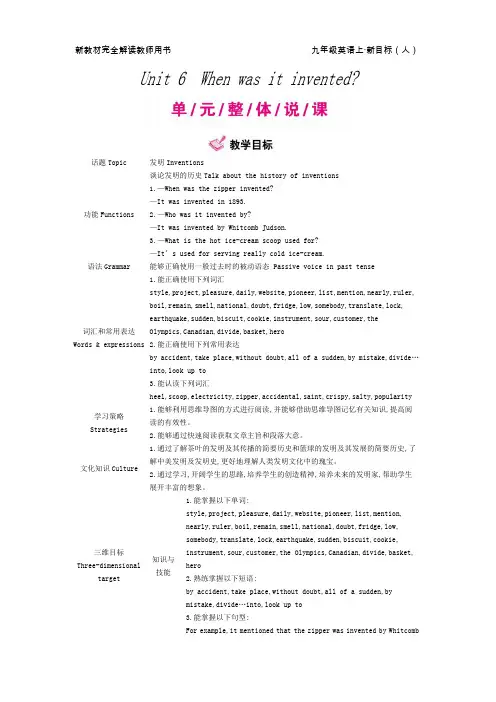
新教材完全解读教师用书九年级英语上·新目标(人)Unit 6 When was it invented?4.能够运用书面语言写新发明介绍。
1.理解、掌握和运用与发明与发明史相关的词汇。
2.理解、掌握和运用一般过去时被动语态的结构。
3.了解不同物品的发明历史。
4.以“Inventions”为话题进行写作。
在教学活动过程中,以“Inventions”为话题,在语言环境中学习和运用一般过去时被动语态语言结构。
对一般过去时被动语态的掌握结合上单元学习的一般过去时的被动语态进行对比分析和掌握。
运用略读、跳读、思维导图等方式进行阅读训练,提高阅读理解的有效性。
第一课时:Section A 1a-2d第二课时:Section A 3a-4c第三课时:Section B 1a-2b第四课时:Section B 2c-Self CheckTo us,it seems so natural to put up an umbrella to keep the water off when it rains.But in fact the umbrella was not invented as protection against the rain,Its first use was as a shade (遮蔽)against the sun.Nobody knows who first invented it,but the umbrella was used in very ancient times.Probably the first to use it were the Chinese in the 11th century B.C.We know that the umbrella was used in ancient Egypt and Babylon as a sunshade.And there was a strange thing connected with its use:it became a symbol of honor and power.In the Far East in ancient times,the umbrella was allowed to be used only by those in high office or by royal people such as the kings or queens.In Europe,the Greeks were the first to use the umbrella as a sunshade.The umbrella was in common use in ancient Greece,but it is believed that the first persons in Europe to use the umbrella as protection against the rain were the ancient Romans.During the middle ages in Europe,the use of the umbrella practically disappeared.Then it appeared again in Italy in the late sixteenth century.And again it became a symbol of power.Umbrellas have not changed much in style during all this time,though they have become much lighter in weight.第一课时Section A 1a—2d1.记忆单词style,project,pleasure,daily,website,pioneer,list,mention;短语have a point。
人教版九年级英语教学设计
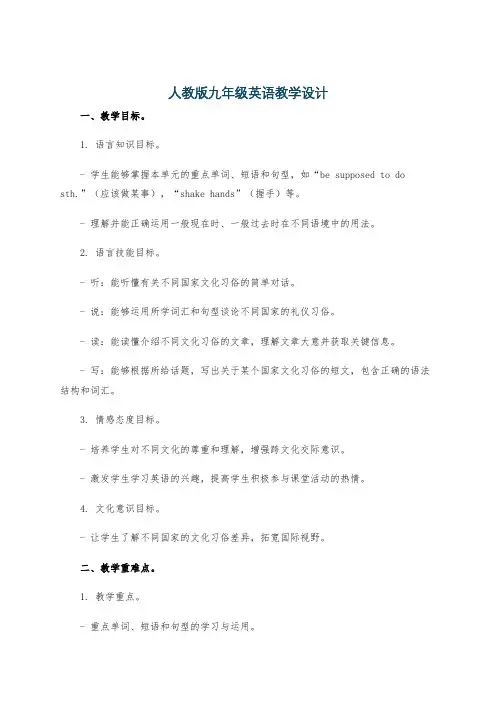
人教版九年级英语教学设计一、教学目标。
1. 语言知识目标。
- 学生能够掌握本单元的重点单词、短语和句型,如“be supposed to do sth.”(应该做某事),“shake hands”(握手)等。
- 理解并能正确运用一般现在时、一般过去时在不同语境中的用法。
2. 语言技能目标。
- 听:能听懂有关不同国家文化习俗的简单对话。
- 说:能够运用所学词汇和句型谈论不同国家的礼仪习俗。
- 读:能读懂介绍不同文化习俗的文章,理解文章大意并获取关键信息。
- 写:能够根据所给话题,写出关于某个国家文化习俗的短文,包含正确的语法结构和词汇。
3. 情感态度目标。
- 培养学生对不同文化的尊重和理解,增强跨文化交际意识。
- 激发学生学习英语的兴趣,提高学生积极参与课堂活动的热情。
4. 文化意识目标。
- 让学生了解不同国家的文化习俗差异,拓宽国际视野。
二、教学重难点。
1. 教学重点。
- 重点单词、短语和句型的学习与运用。
- 理解和掌握不同国家的文化习俗内容。
2. 教学难点。
- 如何引导学生在实际情境中正确运用所学的词汇和句型进行跨文化交际。
- 培养学生根据不同语境准确使用一般现在时和一般过去时描述文化习俗的能力。
三、教学方法。
1. 情景教学法。
通过创设不同国家文化习俗的情景,让学生在真实的语境中学习和运用英语。
2. 任务驱动法。
布置各种任务,如小组讨论、角色扮演等,让学生在完成任务的过程中提高语言综合运用能力。
3. 交际教学法。
鼓励学生积极参与课堂交流活动,提高学生的英语口语表达能力和跨文化交际能力。
四、教学过程。
1. 导入(5分钟)- 播放一段包含不同国家人们见面打招呼场景的视频,如法国人贴面礼、日本人鞠躬、美国人握手等。
- 提问学生:What can you see in the video? How do people greet each other in different countries? 引导学生思考并回答,从而引出本节课的主题——不同国家的文化习俗。
新人教版九年级上册初中英语全册优质公开课教案(教学设计)
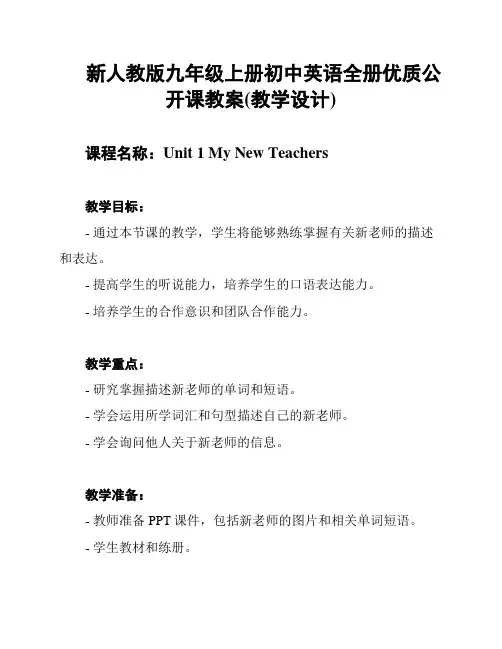
新人教版九年级上册初中英语全册优质公开课教案(教学设计)课程名称:Unit 1 My New Teachers教学目标:- 通过本节课的教学,学生将能够熟练掌握有关新老师的描述和表达。
- 提高学生的听说能力,培养学生的口语表达能力。
- 培养学生的合作意识和团队合作能力。
教学重点:- 研究掌握描述新老师的单词和短语。
- 学会运用所学词汇和句型描述自己的新老师。
- 学会询问他人关于新老师的信息。
教学准备:- 教师准备PPT课件,包括新老师的图片和相关单词短语。
- 学生教材和练册。
教学过程:1. 预导入:- 让学生在教材中找到与新老师相关的对话和信息,引发学生对新老师的讨论。
2. 新课呈现:- 通过PPT呈现新老师的图片,引导学生观察,激发学生对新老师的兴趣。
- 教师朗读并板书相关单词和短语,如:funny, strict, kind, teach, subject, etc.- 帮助学生理解这些词汇的含义和用法。
3. 听力训练:- 播放教材中与新老师有关的录音,要求学生仔细听,并回答问题。
- 教师带领学生讨论录音内容,检查学生对听力材料的理解。
4. 口语表达:- 学生们分组进行合作活动,每组选择一位组员描述自己的新老师,其他组员根据描述的特点猜测是哪位老师。
- 教师在每组间转动,观察学生的口语表达和合作情况,提供必要的指导和帮助。
5. 互动交流:- 分角色进行对话练,有几个学生扮演新老师的角色,其他学生通过提问的方式了解新老师的信息。
- 教师引导学生运用学到的句型和表达方式进行对话,确保每个学生都有参与。
6. 总结反思:- 教师和学生一起总结本节课所学到的词汇、短语和句型。
- 学生们分享本次合作活动的感受和收获。
课后作业:- 完成练册上与新老师相关的练题。
- 列表格,描述自己的新老师,并写出自己对他(她)的评价。
教学延伸:- 学生可以扩展口头表达,介绍其他教师或家人的特点和评价。
- 学生可以编写一段短文,描述自己的梦想老师。
人教版九年级英语全册教案
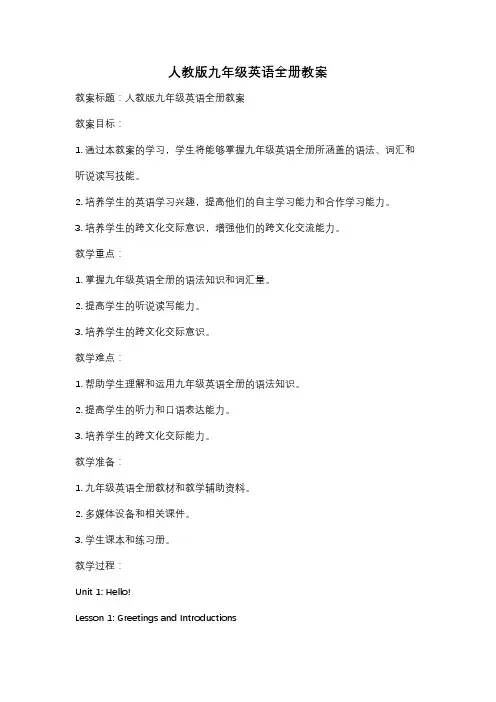
人教版九年级英语全册教案教案标题:人教版九年级英语全册教案教案目标:1. 通过本教案的学习,学生将能够掌握九年级英语全册所涵盖的语法、词汇和听说读写技能。
2. 培养学生的英语学习兴趣,提高他们的自主学习能力和合作学习能力。
3. 培养学生的跨文化交际意识,增强他们的跨文化交流能力。
教学重点:1. 掌握九年级英语全册的语法知识和词汇量。
2. 提高学生的听说读写能力。
3. 培养学生的跨文化交际意识。
教学难点:1. 帮助学生理解和运用九年级英语全册的语法知识。
2. 提高学生的听力和口语表达能力。
3. 培养学生的跨文化交际能力。
教学准备:1. 九年级英语全册教材和教学辅助资料。
2. 多媒体设备和相关课件。
3. 学生课本和练习册。
教学过程:Unit 1: Hello!Lesson 1: Greetings and IntroductionsStep 1: Warm-up- 通过展示与问答的形式,复习和引入与问候和介绍相关的词汇和表达方式。
Step 2: Presentation- 使用多媒体设备和图片,展示不同国家的问候方式和介绍习惯,引发学生的兴趣和好奇心。
Step 3: Practice- 学生分组进行角色扮演,模拟不同场景下的问候和介绍情景,并通过互动练习加深对语言的理解和运用能力。
Step 4: Consolidation- 向学生介绍并解释本课时的重点词汇和语法知识,帮助他们理解和掌握。
Step 5: Extension- 提供一些额外的练习和活动,以巩固学生对本课时所学内容的掌握,并扩展他们的思维和表达能力。
Step 6: Homework- 布置相关的课后作业,包括练习册上的题目和口头作业,以巩固学生对本课时所学内容的掌握。
教学评价:1. 教师通过观察学生在课堂上的表现和参与度,评价他们对本课时所学内容的理解和掌握程度。
2. 学生完成的课后作业和口头作业,以及课堂上的小组活动和角色扮演,也可作为评价学生学习情况的依据。
人教版初中九年级英语教案英文版
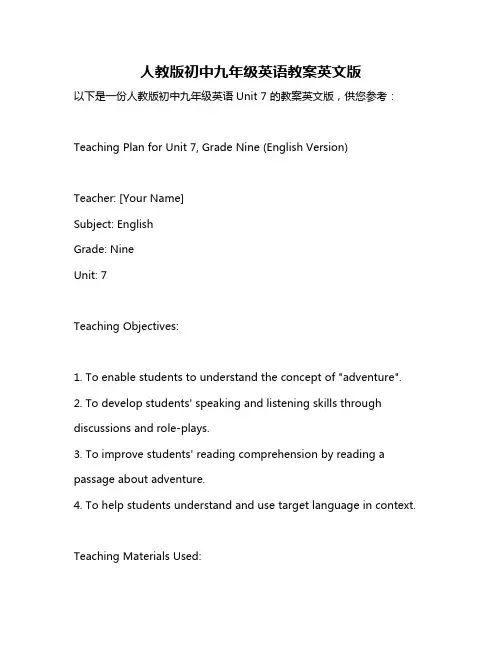
人教版初中九年级英语教案英文版以下是一份人教版初中九年级英语Unit 7 的教案英文版,供您参考:Teaching Plan for Unit 7, Grade Nine (English Version)Teacher: [Your Name]Subject: EnglishGrade: NineUnit: 7Teaching Objectives:1. To enable students to understand the concept of "adventure".2. To develop students' speaking and listening skills through discussions and role-plays.3. To improve students' reading comprehension by reading a passage about adventure.4. To help students understand and use target language in context. Teaching Materials Used:1. Textbook: "English for Grade Nine" (published by People's Education Press)2. Multimedia resources: PowerPoint slides and video clips3. Worksheets: designed to accompany the lessonTeaching Procedures:1. Lead-in (5 minutes): Begin by asking students about their understanding of the concept of "adventure". Use a question like "What is adventure?" to stimulate discussion. Let students share their ideas and use the opportunity to introduce the topic of the lesson.2. Reading Comprehension (15 minutes): Ask students to read a passage about adventure in their textbooks. Provide comprehension questions to check their understanding, such as "What is the main idea of the passage?" or "What are the key points mentioned in the passage?". Encourage students to share their answers with the class.3. Role-plays and Discussions (20 minutes): Divide students into groups and ask them to create a short role-play about a particular adventure experience. Encourage them to use target language from the lesson and to express their ideas through role-plays. Providefeedback on their performances and focus on language accuracy and fluency. After the role-plays, ask students to share their experiences with the class, discussing different aspects of adventure such as challenges faced, feelings during the experience, and lessons learned. Encourage them to use the target language actively in their discussions.4. Listening Practice (10 minutes): Play a video clip about adventure to provide students with a real-life context for language input. After watching the clip, ask students to complete a listening exercise, such as filling in missing information or answering multiple-choice questions. Check their answers and provide feedback on their listening comprehension.5. Summary and Homework (5 minutes): Recap the main points of the lesson and emphasize the target language learned. Assign homework that reinforces the target language, such as writing a short essay about their own adventure experience or creating a list of words and phrases related to adventure. Remind students of the importance of review and practice to enhance their language skills.。
人教版九年级上册英语教案(优秀5篇)
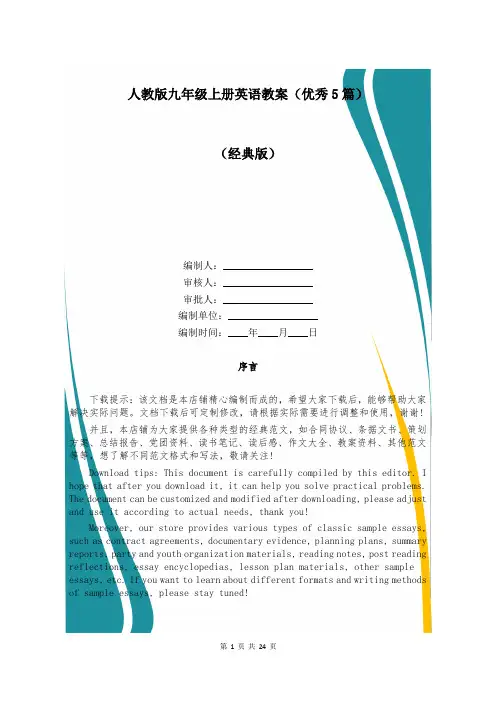
人教版九年级上册英语教案(优秀5篇)(经典版)编制人:__________________审核人:__________________审批人:__________________编制单位:__________________编制时间:____年____月____日序言下载提示:该文档是本店铺精心编制而成的,希望大家下载后,能够帮助大家解决实际问题。
文档下载后可定制修改,请根据实际需要进行调整和使用,谢谢!并且,本店铺为大家提供各种类型的经典范文,如合同协议、条据文书、策划方案、总结报告、党团资料、读书笔记、读后感、作文大全、教案资料、其他范文等等,想了解不同范文格式和写法,敬请关注!Download tips: This document is carefully compiled by this editor. I hope that after you download it, it can help you solve practical problems. The document can be customized and modified after downloading, please adjust and use it according to actual needs, thank you!Moreover, our store provides various types of classic sample essays, such as contract agreements, documentary evidence, planning plans, summary reports, party and youth organization materials, reading notes, post reading reflections, essay encyclopedias, lesson plan materials, other sample essays, etc. If you want to learn about different formats and writing methods of sample essays, please stay tuned!人教版九年级上册英语教案(优秀5篇)九年级是整个初中阶段的重要一年,因此教师需要学习先进的教育理念,认真准备每一次教案。
新人教版九年级英语上册全册教案
新人教版九年级英语上册全册教案教学目标- 帮助学生掌握新人教版九年级英语上册全部教材内容- 培养学生的英语听、说、读、写技能- 提高学生的跨文化交际能力教学计划- 教学内容:日常交际用语、介绍自己- 教学重点:掌握日常交际用语的正确使用- 教学时长:2课时单元二:How do you study for a test?- 教学内容:研究方法、考试准备- 教学重点:研究方法的选择与应用- 教学时长:3课时单元三:Could you please tell me where the restrooms are? - 教学内容:寻求帮助、指路- 教学重点:学会礼貌地寻求帮助与指路- 教学时长:2课时单元四:I used to be afraid of the dark.- 教学内容:过去的经历和惯- 教学重点:掌握过去式的使用- 教学时长:2课时单元五:What are the benefits of going green?- 教学内容:环境保护、可持续发展- 教学重点:理解环境保护的重要性- 教学时长:3课时单元六:I love music that I can dance to.- 教学内容:音乐、电影与艺术- 教学重点:学会表达自己对音乐、电影和艺术的喜好和感受- 教学时长:2课时单元七:Teenagers should be allowed to choose their own clothes.- 教学内容:青少年的权利与责任- 教学重点:理解和讨论青少年应有的权利与责任- 教学时长:3课时单元八:Reading for pleasure- 教学内容:阅读和写作- 教学重点:培养学生的阅读兴趣和写作能力- 教学时长:4课时单元九:Wildlife protection- 教学内容:野生动物保护- 教学重点:了解野生动物保护的重要性,并表达自己的看法- 教学时长:2课时单元十:Musical instruments- 教学内容:乐器与音乐- 教学重点:了解各种乐器和音乐类型,并能进行简单的介绍- 教学时长:3课时教学评价- 结合课堂表现、作业成绩、测试等多种评价方式进行评价- 通过个人表现、小组合作等方式培养学生的主动研究能力- 鼓励学生参与课堂互动,提高口语表达能力参考资料- 教材:新人教版九年级英语上册- 辅助教材:听力材料、课外阅读材料等。
最新 人教版九年级 英语上册全册教案
最新人教版九年级英语上册全册教案第一课时
教学目标
- 研究并掌握单词:hello, hi, goodbye, bye, nice to meet you
- 能够用英语进行简单的自我介绍和问候
- 熟悉并能正确使用句子:Hello, I'm [name]. Nice to meet you. 教学重点
- 研究常用的问候语和自我介绍方式
- 练口语表达能力
教学准备
- 教材《人教版九年级英语上册》
- 教学PPT
教学步骤
1. 导入新课,向学生简要介绍本节课的内容,并激发学生研究
的兴趣。
2. 分发教材,让学生跟读单词:hello, hi, goodbye, bye, nice to meet you。
3. 解释单词的意思,帮助学生掌握词汇。
4. 利用示范和展示图片等方式,让学生理解并掌握句子:Hello, I'm [name]. Nice to meet you.
5. 引导学生进行口语练,让他们用所学内容进行自我介绍和问候。
6. 收集学生的口语表达,进行点评和纠正。
7. 结束本节课,作简单复,并布置下节课的预内容。
教学延伸
- 练更多的问候语和自我介绍方式,丰富学生的口语表达能力。
- 制作小组或角色扮演活动,让学生在真实情境中运用所学内容。
教学评价
- 观察学生的参与程度和口语表达能力,及时给予鼓励和指导。
- 收集学生的口头回答、书面练习,进行评估和改进教学策略。
【名师出品】最新人教版初三(全一册)英语全册精品优质教案教学设计讲义【2017年审定,共313页】
2017人教版九年级(全一册)英语全册精品教案2017年8月制作人教版2017初中九年级(全一册)英语全册精品教案【312页,303042字符】Unit1How can we become good learners?学习目标认知目标:1.Talk about how to study.学会讨论各种学习方法和策略。
2.Find out your suitable learning methods.找出适合自己的学习方法。
情感目标:通过对学习方法的学习,培养学生用正确而科学的方法做事的能力,明白“一份耕耘,一份收获”。
技能目标:(1)熟练掌握下列词汇:aloud pronunciation discover repeat note pronounceincrease speed partner create active connectreview knowledge wisely born attention (2)熟练掌握下列短语:work with friends ask the teacher for helpread aloud look up practice pronunciationconnect…with…pay attention to(3)掌握下列句型:How do you study English?I learn by working with a group.Do you learn English by reading aloud?Yes,I do.It helps my pronunciation.How can I read faster?You can read faster by reading word groups.How can I improve my pronunciation?One way is by listening to tapes.But whether or not you can do this well depends on your learning habits.重点、难点(Key points and difficulties)1.学会运用how来询问做事方式2.学会运用by+doing的结构表达做事方式。
人教版九年级上册英语教案5篇
人教版九年级上册英语教案5篇人教版九年级上册英语教案(篇1)一、指导思想以我区初中英语教学教研工作为指导,立足学校整体教学工作,以提高教研质量为目标,增强学习意识、服务意识、教研意识、质量意识、合作意识,充分发挥专业职能作用,以新课改为契机,以更新教育教学理念为导向,以课堂教学改革为重点,并注重培养学生的创新精神和实践能力,从而不断深化课堂教学改革,全面提升我校英语教研水平。
二、工作要点:1.加强教学常规的精细化管理,全面提高教学质量。
1).强化教学常规的落实,提高课堂教学效率,组织教师认真学习学校教学常规,指导检查教师的教学工作,进一步加强学科教学五环节的研究与管理,特别抓好“备课”、“上课”、“课后辅导”、“培优辅导”等主要环节,本学期聚焦“上课、作业”环节,注重教学的有效性。
特别在作业上统一标准,统一格式,统一订正,同时根据学生不同情况作业有分层。
2)组织英语课外活动和比赛。
做好期中期末命题的双向分析,跟踪补缺补差学生的成绩,加强月考命题分析的讨论和实施。
及时了解学生学习情况,调整教学和命题。
在教研组内部建立教学评价和质量保证体系,达到自我诊断、自我调节、自主发展的目的。
在英语教学中,我们提倡精选练习,精心编练,因材施教。
进一步做好英语方面的差距和差异的弥补。
加强九年级毕业班工作研究,提高毕业班教学效率。
加强对中考走势的信息收集和测试研究,集中精力,争取在九年级中考中取得一个满意的成绩。
2.?以教科研引领,为教师的专业化成长打造新的平台。
1).大力开展校本教研,拓宽教师课程视野,逐渐成为学习型、反思型教师。
通过同伴互动。
充分发挥学校骨干教师、优秀教师的作用,通过“共享式的集体备课”、“探究式的课堂实践活动”和“专题式的学习讨论活动”等促进教师之间的互动,营造“集体备课、资源共享、个人加减、教后反思”的教研氛围。
结合优质课堂活动,并且推出一节具有代表性的研讨课。
(陈美红老师开课)2).根据各年级特点,进行一次主题教研活动。
- 1、下载文档前请自行甄别文档内容的完整性,平台不提供额外的编辑、内容补充、找答案等附加服务。
- 2、"仅部分预览"的文档,不可在线预览部分如存在完整性等问题,可反馈申请退款(可完整预览的文档不适用该条件!)。
- 3、如文档侵犯您的权益,请联系客服反馈,我们会尽快为您处理(人工客服工作时间:9:00-18:30)。
2017新人教版九年级英语教案现在九年级英语书又换成新人教版了,那么对于这本新书,英语老师们该怎么写教案呢?下面是小编带来的2017新人教版九年级英语教案,欢迎英语老师们来参考参考!2017新人教版九年级英语教案一Unit 1一、知识点1.Check in : 在旅馆的登记入住。
Check out: 在旅馆结账离开。
2.By: ①通过..方式(途径)。
例:I learn English by listening to tapes.②在 ..旁边。
例:by the window/the door③乘坐交通工具例:by bus/car④在之前,到为止。
例:by October在10月前⑤被例:English is spoken by many people.3.how与what的区别:how通常对方式或程度提问,意思有:怎么样如何,通常用来做状语、表语。
what通常对动作的发出者或接受者提问,意思为什么,通常做宾语,主语。
①How is your summer holiday? It s OK.(how表示程度做表语)②How did you travel around the world? I travel by air.③What do you learn at school? I learn English, math and many other subjects.①What think of ? How like ?②What do with ? How deal with ?③What like about ? How like ?④What s the weather like today? How s the weather today?⑤What to do? How to do it?e.g. What do you think of this book?=How do you like this book?I don t know what I should do with the matter.=I don t know how I should deal with it. What do you like about China?=How do you like China?I don t know what to do next step?=I don t know how to do it next step?㊣What good / bad weather it is today!(weather为不可数名词,其前不能加a )㊣What a fine / bad day it is today! (day为可数名词,其前要加a )4. aloud, loud与loudly的用法: 三个词都与大声或响亮有关。
①aloud是副词,重点在出声能让人听见,但声音不一定很大,常用在读书或说话上。
通常放在动词之后。
aloud没有比较级形式。
如: He read the story aloud to his son.他朗读那篇故事给他儿子听。
②loud可作形容词或副词。
用作副词时,常与speak, talk, laugh等动词连用,多用于比较级,须放在动词之后。
如:She told us to speak a little louder. 她让我们说大声一点。
③loudly是副词,与loud同义,有时两者可替换使用,但往往含有令人讨厌或打扰别人的意思,可位于动词之前或之后。
如:He does not talk loudly or laugh loudly in public. 他不当众大声谈笑。
5. voice 指人的嗓音也指鸟鸣。
sound 指人可以听到的各种声音。
noise 指噪音、吵闹声6. find + 宾语+ 宾补(名词形容词介词短语分词等)例:I find him friendly. I found him working in the garden.We found him in bed. He found the window closed.We found her honest.7. 常见的系动词有:①是:am 、is、are②保持:keep、stay③转变:become、get、turn④起来feel、look、smell、taste、sound8. get + 宾语+宾补(形容词过去分词动词不定式) 使某种情况发生例:Get the shoes clean. 把鞋擦干净Get Mr. Green to come. 让格林先生进来I want to get my bike repaired. 我想去修自行车You can t get him waiting. 你不能让他老等着9. 动词不定式做定语①与所修饰的名词构成主谓关系The next train to arrive was from New York. He is always the first to come.②与所修饰的名词构成动宾关系I have nothing to say. I need a pen to write with.I need some paper to write on. I don t have a room to live in.10. practice , fun 做名词为不可数名词11. add 补充说又说12. join 加入某团体并成为其中一员attend 出席参加会议或讲座join in与take part in指参加到某项活动中去。
13.all、both、always以及every复合词与not连用构成部分否定。
其完全否定为:all---none, both---neither, everything---nothing, everybody---nobody.14. be afraid of doing sth. / sth.害怕be afraid of being alonebe afraid to do sth.害怕be afraid that恐怕担心,表示委婉语气15.either:①放在否定句末表示也②两者中的任一③either or 或者或者. 引导主语部分,谓语动词按照就近原则plete完成,是个较正式的词,后不能接动名词finish指日常事物的完成17.a,an 与序数词连用表示又一,再一。
例:Please give me a second apple. There comes a fifth girl.18.have trouble/difficult/problem (in) doing .. 干..遇到麻烦,困难19.unless 除非,如果不,等于if not 本身就表示否定,引导条件状语从句,主句为将来时,条件状语从句用一般现在时表示将来。
例:My baby sister doesn t cry unless she s hungry.=My baby sister doesn t cry if she isn t hungry.Unless you take more care, you ll have an accident.如果你不多加小心的话,你会出事的。
20.instead: adv. 代替,更换。
例:We have no coffee, would you like tea instead?我们没有咖啡了,改喝茶好吗?It will take days by car, so let s fly instead.开车去要好几天呢,咱们还是坐飞机吧。
Tom was ill, so I went instead.汤姆病了,所以换了我去。
instead of doing sth. 作为某人或某事物的替换例:Let s play cards instead of watching TV.We sometimes eat rice instead of potatoes.Give me the red one instead of the green one.21.spoken 口头的,口语的。
spoken English 口头英语speaking 讲话的,说某种语言的。
Speaking skills讲英语的能力22. 提建议的句子:①What/ how about +doing sth.? 如:What/ How about going shopping?②Why don t you + do sth.? 如:Why don t you go shopping?③Why not + do sth. ? 如:Why not go shopping?④Let s + do sth. 如:Let s go shopping⑤Shall we/ I + do sth.? 如:Shall we/ I go shopping?23. a lot 许多常用于句末如:I eat a lot. 我吃了许多。
24. too to 太而不能常用的句型too+adj./adv. + to do sth.如:I m too tired to say anything. 我太累了,什么都不想说。
25. not at all 一点也不根本不如:I like milk very much. I don t like coffee at all.。
